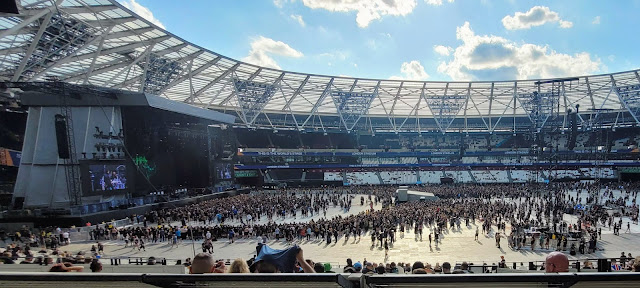Archbishop's Park, Lambeth, is a wonderful park that sits just to the east of Lambeth Palace Gardens. In fact it was once part of Lambeth Palace Gardens, before Archbishop Archibald Campbell Tait opened over 9 acres of land for use by the poor of the area.
Besides the usual sports fields and courts, there is a wonderful play area, a stunning bench, a community orchard, gardens and much more.
A path that flows through the park has stepping stone plaques, embedded in the tarmac, which chart the history of the area, along with some of the area's more famous names.
It was unveiled in June 2000 with local residents choosing the subjects of the plaques.
Plaques Timeline
1000 - Lambeth is mainly marshland and open countryside punctuated by Roman roads and a few small settlements
1041 - The Anglo Saxon chronicle records 'This year died Hardicanute at Lambeth, as he stood drinking'.
1087 - Domesday Book lists Lambeth, or Lanchei, as belonging to Countess Goda, sister of Edward the Confessor.
1197 - The Manor of Lambeth is acquired by the Archbishop of Canterbury. The building of Lambeth Palace begins during this period.
1339 - Edward III gives Kennington to the Black Prince, who builds a palace.
1534 - Sir Thomas More refuses to swear allegiance to the King at Lambeth Palace.
1605 - Guy Fawkes and his fellow conspirators store their gunpowder in a house in Lambeth.
1634 - Tradescant opens his museum of curiosities to the public.
1661 - John writes of his 'Pretty Contrived
1731 - Birth of Henry Cavendish who weighed the world at Clapham.
1740 - Death of Margaret Finch Queen of the Norwood Gypsies aged 109.
1760 - Dr Johnson stays with the Thrales at Streatham Place.
1770 - Campaign tp abolish slavery is spearheaded by the Clapham Sect.
1771 - Opening of Astley's Amphitheatre in Westminster Bridge Road. The first indoor circus.
1793 - William Blake writes of 'Songs of Experience' while living in Hercules Road.
1802 - A hermit called 'Matthews the Hairyman' lives in a cave in the remote Norwood hills.
1820 - Henry Potter breeds leeches at Streatham to supply the London hospitals.
1826 - Doulton and Watts begin making pottery from premises in Lambeth High Street.
1848 - Mass meeting of Chartists on Kennington Common to present a petition to Parliament
1853 - The Crystal Palace moves from Hyde Park to the Norwood Ridge and the surrounding area develops rapidly.
1880 - Clapham Rovers win the FA Cup.
1898 - Charlie Chaplin leaves Kennington Road School to join a Clog Dancing Troupe, aged nine.
1902 - WG Grace plays at Streatham Cricket Club, known as one of the most attractive grounds in the country.
1936 - Lupino Lane sings 'The Lambeth Walk' in the show 'Me and My Girl', and it becomes an international dance craze.
1938 - Alfie Howard, Lambeth's Town Crier, attends his first function. He's still working at the age of 87 as this path is made.
1945 - Lambeth Baths receives a direct hit from a V2 rocket. Thirty seven people are killed in Lambeth's worst incident of World War II.
1948 - The Empire Windrush docks in Southampton, the post-war immigration from the West Indies begins and Brixton's black community flourishes.
1951 - The Festival of Britain and the redevelopment of the South Bank.
1981 - The Brixton Riots act as a catalyst for change and regeneration in the inner city.
1990 - Brixton produces its first Prime Minister, John Major.
2000 - Ken Livingstone, Lambeth born and bred, becomes London's first elected Mayor. The London Eye transforms the London skyline.






















